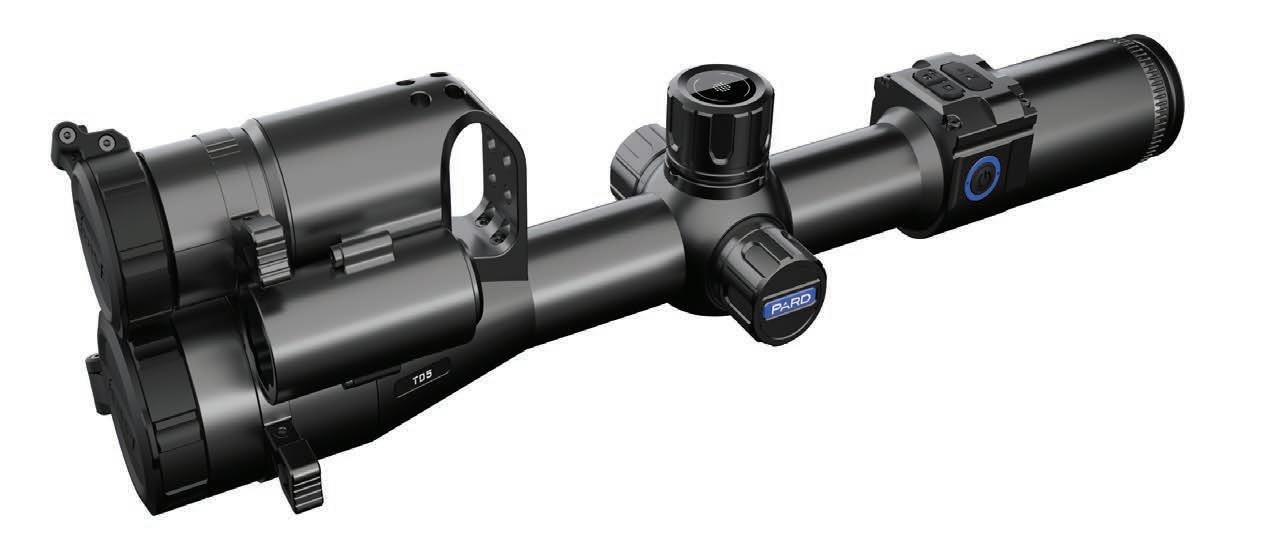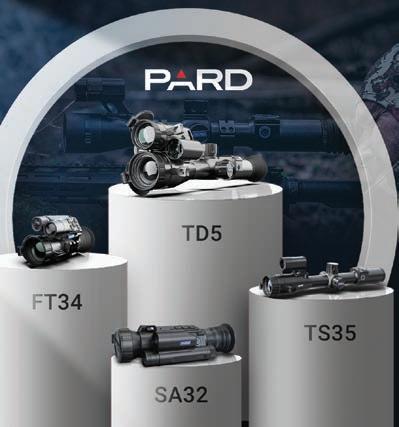
5 minute read
Vision Quest
The goal at PARD is to not only improve night-vision and thermal-imaging devices, but customer service as well.
Derick Cole is an experienced industry professional and the vice president of sales for PARD USA, where he leads sales and marketing strategies and manages customer relationships. He has been in the outdoor industry for more than 25 years, and during his career he has spent time with national distributors and manufacturers in the optics, firearms, outdoor, and fishing categories.
Cole earned a bachelor’s degree in Business Management in 2004 and a master’s degree in Organizational Management in 2006. Apart from managing PARD, Cole is an active hunter and fly fisherman who donates his time to the Boy Scouts of America as a Merit Badge counselor.
SHOT business: What do you see as the biggest challenges facing the industry in the next five years?
Derick Cole: Consumer education. Interest in the thermal and night vison space has exploded in recent years. There are a lot of technical elements that must be considered when comparing brands, models, and features. One of the main things that sets PARD apart from our competitors is our “value proposition.” PARD generally offers higher technical specifications and more built-in features at competitive retail price points than any of our competitors. The consumer gets higher performance and value for their money. The challenge with thermal and night vision has been explaining and simplifying the technical performance elements to make it easy to understand so that end users can make an intelligent decision when purchasing a device.
SB: What opportunities do you see?
DC: Customer service is an area that has been overlooked by many in the industry. Too many brands have looked past this important part of building consumer trust and retail partnerships. Our technical support department is in our corporate office in Reno, Nevada. We have inhouse personnel that correspond directly with consumers to help identify and correct any issues that may arise. Our customers will not have to deal with overseas phone trees or substandard response times.
Another opportunity is to bring back profitability to the retailer in this category. PARD offers margins that are in some cases 10- to 15-percent higher than other brands. This is a game changer. We understand that while many of us are in this industry because we love it, none of us do it for free. It is important to be profitable.
Sb: When you get up in the morning, what gets you excited about working in the industry?
DC: Over the last 25 years I have never been as excited about a brand or company as I am with PARD. Building the brand around retail margins, consumer value, and customer service are the three key pillars of our strategy. Fortunately, we do not have any negative perceptions or operational issues that will hold us back. In 2023, we are launching into the U.S. marketplace after more than five years of double-digit growth in Europe and industry recognition with two consecutive “Product of the Year” awards from the British Shooting show. We are excited to bring the quality and reputation we have established to the USA marketplace and to help night vision products.
SB: In a very competitive world, how does PARD stay ahead of the pack and what should customers expect?
DC: We are already ahead of the pack with quality, price, and value. Our job is to communicate that position with retailers and consumers.
PARD owns its own factory, so product development, production, and timelines are all controlled internally. Company engineers develop new products to the highest quality standards and R&D is constantly ongoing to stay ahead of the technological curve. A good example of this is our recently announced TD5 Dual Spectra Imaging device that combines night vision and thermal detection into a single unit. It is the first of its kind in the industry.
Consumer education will also be at the forefront of our strategic efforts this year. It is vital to share what is important when considering a thermal or night vision device—and why. Information is key, and PARD wants every consumer and retail partner to know that we have their best interests at heart in explaining this dynamic optics category. We will commit advertising and digital resources to help clarify product features and key technical elements for consumers.
We are also committed to directly supporting all our retail partners in driving sales. Over the last two years some competing brands have adopted a strategy to sell consumers direct through opening branded brick-and-mortar stores in the Texas and Florida markets, effectively competing directly with the retailers that have supported them over the last 10 to 15 years. This is a strategy we do not support. We will never undermine our partnerships through this kind of approach.
The TD5 combines long-distance thermal detection, high-definition night vision, and a laser rangefinder into a single unit.
SB: Could you explain the differences between night-vision and thermal-imaging technologies?
DC: Night vision requires amplification of some form of visible light. Thermal-imaging technology operates by utilizing infrared sensors to detect temperature differences between targets in the environment.
SB: What are the pros and cons of each, and the best uses of each?
DC: Night vision works by amplifying ambient light available to the sensor, typically creating a green-hue image that can be viewed in near total darkness. Night-vision light sensitivity is measured in lux, the smaller the number the better. Lux is defined as the amount of illumination created when one lumen is distributed over an area of one square meter. PARD night-vision devices are sensitive down to .001 lux. This is roughly equivalent to being able to see a lit match on the 50-yard line of the Super Bowl when sitting in the top row of the stadium. Night vison also operates effectively through glass or a window while thermal sensors will not.
Thermal does not require any ambient light to function and works equally well during the day or night. Targets with higher heat signatures are generally displayed in bright yellow, orange, or red colors. Sensitivity is defined by the Noise Equivalent Temperature Difference (NETD) and degrees are measured in millikelvin (mK). This is a critical technical specification when considering a thermal device. Again, the smaller the number the better. All PARD thermal units are sensitive down to an industry leading 25mK. Many of our competitors come in at 35mK, 40mK, or even 50mK (half as sensitive as a PARD device).
Environmental conditions such as airborne dust, cloudy nights, precipitation, smoke, or fog can adversely impact the effectiveness of night vision products. These conditions have virtually no effect on thermal, which can be used in complete darkness. Night vision provides better target identification whereas thermal provides better detection. Night vision devices are also generally less expensive than thermal devices.
SB: What are the best sales tactics for retailers to successfully sell these products?
DC: Retailers need to understand that staff training and providing general product knowledge to the customer will play a critical role in helping consumers navigate this often-confusing world. PARD is committed to helping our retail partners with technical information, POP support, and in-store merchandising support that will help drive sales. (pard.com)
The PARD family of products includes night vision scopes as well as thermalimaging technology. PARD offers its retailers a high level of technical and POS support designed to help drive sales.












